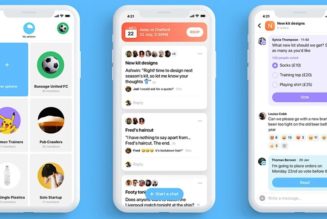The Raspberry Pi Foundation has announced the Raspberry Pi 400, a compact keyboard with an ARM-based computer built in. Just plug it into a TV or monitor using one of its two micro HDMI ports, insert a microSD card, attach a power cord and mouse, and you’ve got yourself a basic computer for day-to-day tasks, coding, or media playback. It’s available starting today as a standalone machine for $70 or in a bundle including a mouse, power supply, microSD card, HDMI cable, and beginner’s guide for $100.
The hope is the Pi 400’s form factor, plus these optional bundled items, makes it more approachable and user-friendly. That’s important when you’re selling an affordable computer, and it’s especially important when you’re selling an accessible device to help children learn to code. It looks more like a piece of consumer electronics than the basis for a DIY project.
“It can sit under your Christmas tree and… if you open your presents at 9 o’clock, by 10 o’clock you can be sitting in front of your television with a computer,” Raspberry Pi’s founder, Eben Upton, tells me in an interview ahead of the announcement.
The Raspberry Pi 400’s form factor immediately brings to mind early home computers like the BBC Micro or ZX Spectrum, and that’s no accident. Although Raspberry Pi’s small computers have become a popular tool for hobbyists to do everything from building inexpensive AirPlay receivers to automating smart homes, at their core they’re designed as accessible computers to help children learn to code.
“The dream always with Raspberry Pi is to lure people into buying a PC and then trick them into becoming computer programmers,” Upton says. “That’s what happened to me, I was lured into buying a BBC Micro and then suddenly I became a software engineer.”
Aside from its keyboard and form factor, the Raspberry Pi 400 is a very similar computer to last year’s Raspberry Pi 4. It’s got a slightly faster quad-core 1.8GHz ARM Cortex-A72 CPU, up from 1.5GHz in the Pi 4, 4GB of RAM, Gigabit Ethernet, Bluetooth 5.0, and 802.11ac Wi-Fi. There are a pair of micro HDMI ports that can each output up to 4K / 60Hz, two USB 3.0 ports, and a single USB 2.0 port. Power is provided via a USB-C port, there’s a microSD card slot for storage, and there’s a GPIO header for attaching a variety of more niche devices.
:no_upscale()/cdn.vox-cdn.com/uploads/chorus_asset/file/22002642/RPI_400_TOP_DOWN_REAR_WHITE.jpg)
:no_upscale()/cdn.vox-cdn.com/uploads/chorus_asset/file/22002643/RPi_400_FRONT_WHITE.jpg)
While the internals are similar to previous Raspberry Pi devices, the external appearance of the Pi 400 is anything but. Depending on which region you buy it in, the computer is built into either a 78- or 79-key keyboard, which has a similar design to most compact laptop keyboards. At launch, there are six different keyboard layouts — UK, US, German, French, Italian, and Spanish — and Upton tells me there are additional variants for the Norwegian, Swedish, Danish, Portuguese, and Japanese markets on the way soon.
Thankfully, this isn’t Raspberry Pi’s first keyboard — it released a standard one without a computer built into it last year. I say thankfully because many of those early ‘80s home computers had absolutely awful keyboards, and producing a practice keyboard should help Raspberry Pi avoid any serious mishaps. Upton tells me the company’s approach was inspired by how PC manufacturer Acorn Computers used its standalone keyboard as a basis for the Acorn Atom computer. In fact, Upton says that keen-eyed observers would have seen hints about the Pi 400’s development hidden inside its standalone keyboard, which has a slightly unnecessary amount of empty space inside it where the Pi 400’s computer innards now sit.
:no_upscale()/cdn.vox-cdn.com/uploads/chorus_asset/file/22002648/KIT_11.jpg)
It’s not just children learning to code to whom the company wants to sell Pi 400s. “Who’s it supposed to help? It’s supposed to help anyone who needs a computer,” Upton says. Interestingly, that also includes businesses, with Upton telling me that the company sees the Raspberry Pi 400 being used as corporate desktop machines or for call center agents. Interestingly, that’s one of the reasons why the Raspberry Pi 4 and Pi 400 have two HDMI outputs, because two monitors is the default for a lot of business users.
That said, Upton admits that the Pi 400’s pink and white color scheme won’t be to every business’s tastes. “We’re going to need to make it in gray and black and it’s going to break our hearts,” he jokes, “We make our products in pink and white and we think it’s the right color and then we are dragged kicking and screaming to gray and black.”
It may have sounded unrealistic a few years ago to dream of an office filled with ARM-based computers when the processors were largely considered too low-power for anything beyond phones and tablets, but in a year when Apple is starting to switch its Mac computers to the architecture, that future doesn’t look so preposterous.
Upton calls Apple’s upcoming switch a “validation” of ARM’s status as a real PC architecture, and he says it’s proof that PCs aren’t synonymous with x86 processors any more. In the longer term, he says that the change should incentivize more developers to make or optimize their software to run better on ARM, and that whatever happens on macOS is likely to benefit the open-source ecosystem and eventually the Raspberry Pi.
Unless you’re willing to do some serious tweaking, the Raspberry Pi 400 is always going to be a Linux PC. That’s perfect if you’re someone looking to learn to code, but it’s still going to be an unfortunate barrier for many Windows and Mac owners who are looking for a simple machine for everyday computer tasks. For others, the kinds of web browsing, email answering, and productivity tasks that the Pi 400 is powerful enough to perform may already be served just fine by a smartphone.
But with a starting price of $70, the Raspberry Pi 400 is a lot less expensive than even the most budget handsets, and it comes with a keyboard that’s big enough to do proper writing on. For many people, and students in particular, that could just be exactly what they need in a year when a lot of people are still working from home and in need of a computer.
The Raspberry Pi 400 is available starting today. The $100 kit is available now in the UK, US, and France, with availability in Italy, Germany, and Spain following next week. Meanwhile, the $70 standalone version is available now in the UK, US, France, and Germany, and it’s coming to Italy and Spain next week. Releases in India, Australia, and New Zealand will follow by the end of the year.










